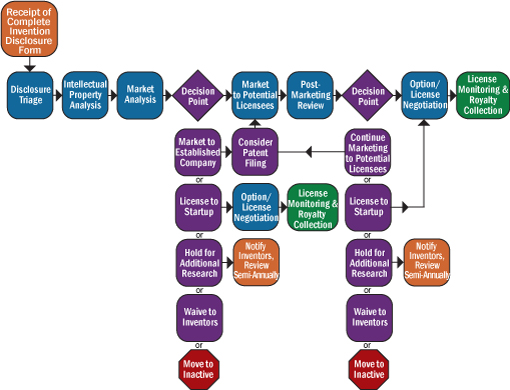Intellectual property (IP) is property that can be protected under federal law including copyrightable works, ideas, discoveries, and inventions. The four classes of intellectual property are patents, copyrights, trademarks and trade secrets.
Additional Information on IP:
Training & Learning Resources (on-demand videos and materials)
Intellectual Property in Student-Developed Inventions: FAQs
(For Students and Faculty)
Ownership of the inventions created by students enrolled on a campus of the University of Missouri System (“University of Missouri” or “University”) is governed primarily by Collected Rule and Regulation (“CR&R”) 100.020.D.6. This document is intended to provide the University’s faculty members and students with guidance in its interpretation.
The Frequently Asked Questions address the ownership of student-generated inventions vis-à-vis the student and the University when the student is a legal inventor. Importantly, even if the University does not have ownership of an invention via the student-inventor’s contribution, in many instances, the University may still have an ownership interest in the invention via the inventor contributions of a faculty member or other University employee. That is, the invention may have both a student-inventor who is not obligated to assign his/her rights in the invention to the University and a co-inventor who is obligated to assign his/her rights in the invention to the University. If that is the case, the University and the student will co-own the intellectual property rights in the invention.
Invention Disclosure Evaluation and Commercialization Pathways
The flowchart below shows each stage of the disclosure evaluation process. After the initial review stages, and at intervals through the evaluation, the disclosure file is reviewed to determine whether to invest University resources. In many cases, the need for a decision will be in response to an upcoming deadline. → Download
Evaluation Flowchart (PDF)
The University of Missouri St. Louis' revenue distribution policy, implemented July 1, 2021, for licensed Intellectual Property (patent rights, copyrights, plant varieties, trademarks etc.) is as follows after expenses:
- Inventor/Author Share: 1/3 to Inventor(s) / Author(s)
- Campus Share: 2/3 to campus technology transfer office to support further R&D and commercialization activities
- The campus share of revenues is first used to cover costs to patent and market technologies, along with activities to increase innovation in research, up to $150,000.
- The campus share revenue received by UMSL above $150,000 will be split 50:50 between the TTO and the inventor(s) / author(s) originating department(s)/unit(s).
